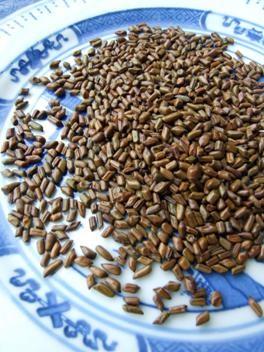Semen Cassiae
- Name
- Origin
- Where Does It Grow?
- Nature and Flavor
- Identified Active Components / Major Chemical Constituents
- Drug Actions in TCM
- Traditional Uses in TCM
- Pharmacological Actions
- Toxicology
- Administration and Dosage
- Adverse Effect, Side Effects and Cautions
- References
Name
Latin Name: Semen Cassiae
Common Name: Cassia seed
Scientific Name: Cassia obtusifolia L. / Cassia tora L.
Chinese Name: 決明子
Pinyin Name: jue ming zi
Origin
Cassia seed is the ripe seed of the annual plant Cassia obtusifolia L., or Cassia tora L., of the Leguminosae family.1
Where Does It Grow?
Cassia seed is widely cultivated in China, and mainly produced in provinces like Anhui, Guangxi, Sichuan, Zhejiang and Guangdong. 1,5
Nature and Flavor
Cassia seed is sweet, bitter and salty in flavor, mild cold in nature, and mainly manifests its therapeutic actions in the liver and large intestine meridian.1,2
Identified Active Components / Major Chemical Constituents
In the Pharmacopoeia of People's Republic of China (2010 Edition) - Part I, the level of chrysophanol should not less than 0.20%, and the level of aurantio-obtusin should not less than 0.080%, as the standard qualities of cassia seed.

Drug Actions in TCM
Cassia seed clears liver heat, sharpens eyesight, lubricates intestines and promotes bowel movements.2Traditional Uses in TCM
Fried cassis seed is commonly used in Chinese medicinal dishes for protecting liver, improving vision, lowering blood lipids and pressure.
Pharmacological Actions
Toxicology
Animal studies have found that anthraquinone compounds contain in the medicinal plants are carcinogenicity, and hydroxy anthraquinone compounds such as emodin, dihydroxyanthraquinone and aloe-emodin may induce reproductive toxicity (e.g. poisonous to the testicle or bone marrow cells). However, the amount of these compounds in cassis seed are low, and thus the toxicity and carcinogenic effects of cassis seed need further study. For fried cassis seed, as the structure of anthraquinone compounds are damaged by high temperatures, their actions are diminished obviously.4,7
Administration and Dosage
For decoction, the usual dosage of cassia seed is 9~15g; it can be higher to 30g if necessary. Cassia seed may also be ground to make pills or as powder for oral administration. Fried cassia seed 3g is used to prepare tea.4
Adverse Effect, Side Effects and Cautions
References
- Li Jiashi (editor-in-chief), Chinese Medicine Identification, Shanghai Scientific and Technical Publishers, 2000-2.
- Lui Daiquan (editor-in-chief), Chinese Herbal Medicine, Shanghai Scientific and Technical Publishers, 2000-6.
- Tao Yufeng, Clinical Herbal Medicine, People’s Medical Publishing House, 2005-5.
- Chen Pian, Clinical Application of Tonifying Herbs, Second Military Medical University Press, 2008-8.
- Nanjing University of Chinese Medicine (edited), Materia Medica, Shanghai Scientific and Technical Publishers, 2005-5.
- http://baike.baidu.com/subview/20881/5679215.htm
- http://www.zysj.com.cn/zhongyaocai/yaocai_j/juemingzi.html


